

Author Veronica Roth with producers Doug Wick and Lucy Fisher.
ENTER HOLLYWOOD
Red Wagon Entertainment producers Doug Wick and Lucy Fisher came upon the manuscript before it was published and were smitten with what they read. They immediately brought the book to Gillian Bohrer, Executive Vice President of Production and Development at Lionsgate. Gillian remembers reading Divergent for the first time one weekend in January 2011. As the book wasn’t published yet, she was reading photocopied pages in a coffee shop, and the page that described Tris’s decision at the Choosing Ceremony was . . . missing. “I had to know what happened!” says Bohrer. “I read ahead and figured it out. And then I couldn’t stop reading. I just couldn’t put it down.”
That Monday morning, she started spreading the word at Summit. “I knew the story would break through to a movie audience,” Bohrer remembers. “It had so many themes that would resonate with teens, from challenging your limits to finding your own family. Plus it had these amazing set pieces, from the Choosing Ceremony to the Ferris wheel and the zip lining. . . . I could see them in my head, just when I was reading, and I knew they would make for a fantastic film.”
When Summit’s Erik Feig was in New York a few weeks later, he met with Veronica Roth’s film rights manager, Pouya Shahbazian. “Erik Feig came in with a game plan,” Shahbazian says. “A playbook. He loved the novel, and Summit knew to a T what it would take to make Divergent into a larger franchise.” Two months before the novel was published and became an immediate success, Shahbazian and Red Wagon sold the movie rights to Summit, with partners Red Wagon attached to produce. “Veronica’s books are so well written and the characters are so engaging,” says Rob Friedman, cochairman of Lionsgate Motion Picture Group, “that readers become captivated from the very first page. As a studio, it is stories and the characters found in book series like Divergent, which make for great source material for film. When you have great content, it becomes easier to bring it to life. We are fortunate that Veronica chose Summit Entertainment to be a partner to create a visual experience that matches what she has worked tirelessly to create. We look forward to delivering what we collectively have worked on with the release of Divergent and can’t wait to see subsequent films based on the franchise.”
Summit Entertainment was the studio behind the wildly successful Twilight films as well as The Hurt Locker, the 2010 Academy Award winner for Best Picture. It had a proven track record of making high-quality films as well as lush adaptations of young adult properties. And the Red Wagon producers, Doug Wick and Lucy Fisher, had been in the business for decades, creating classic films from Gladiator to The Great Gatsby.
Unquestionably, Roth and Divergent were in good hands.

Author Veronica Roth with producer Lucy Fisher.
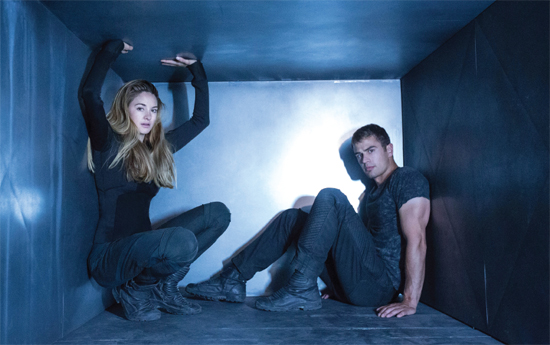
Tris (Shailene Woodley) and Four (Theo James) explore Four’s fear landscape.
Doug Wick also remembers reading the book for the first time and being struck by its epic reach. Of the many potential projects he was considering at the time, Divergent stood out right away. He explains, “For me, it always starts with the story. And Divergent takes elements of a whole lifetime and compresses them into one moment in Tris’s life. These are universal themes: You leave home, and your parents become a sort of blank to you. Then you begin to realize that they’re more than you thought they were. At the same time, you move from familial love to romantic love. Later, you integrate romantic and familial love. And then you lose your parents . . . so much of this arc appears in Divergent, and we’re only with Tris for a few months of her life.”
Wick felt an immediate connection to the story and saw many opportunities to make a film version of Divergent that was narratively and visually stunning. Divergent could deliver action and suspense, but at its core would be a character very different from the kind of character you’d usually find in an action film. Like Veronica Roth, Wick was captivated by Tris’s strength and determination. “With a female protagonist, we’d breathe new life into a genre,” he says. “Male clichés have become tiresome in action films. But credible, strong female protagonists . . . that was a huge untapped opportunity.”
In addition, he loved that the novel gave readers unique access to Tris’s inner life in the fear simulations, and he was eager to take on the challenge of dramatizing them on film. In these sequences, filmmakers would be able to access Tris’s thoughts and feelings in a way that movies normally don’t allow.
FINDING A SCREENWRITER
Producers Wick and Fisher, in cooperation with the team at Summit, began to explore how they would translate Roth’s story into a different medium. The first step would be to develop a screenplay; from that, everything else would follow. Summit and the producers asked screenwriter Evan Daugherty, who had recently written Snow White and the Huntsman, to adapt Roth’s novel.
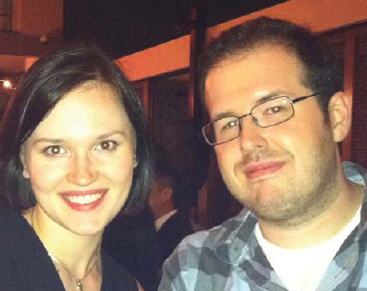
Author Veronica Roth with screenwriter Evan Daugherty.
Daugherty remembers what initially drew him to the project: “Tris starts off in this incredibly sheltered, selfless, peaceful world, and then basically she decides to join the equivalent of the navy SEALs. That’s a big character arc—it’s fun to track that,” he told bloggers at Bookish. Daugherty responded viscerally to the book’s action sequences, but in the screenplay he took great care to balance them with the growing romance between Tris and Four. “It’s important that the chemistry between them doesn’t just feel like it’s thrown in,” he explained, “but that it helps Tris grow as a character.” Skillfully, he showed Tris’s character development within the framework of fast-paced action and ensured that each fear simulation scene drove the story forward.
When the screenplay was complete, and all involved were pleased with it, the search for a director began.
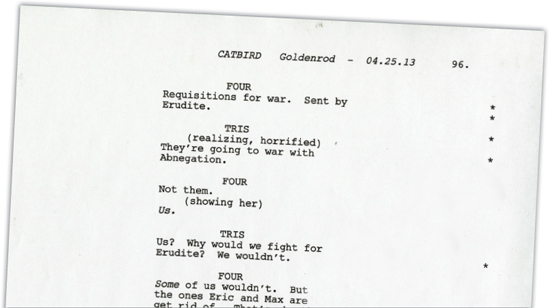
A page from the Divergent movie script, nicknamed Catbird.
. . . WHO WILL DIRECT?
Summit and the producers had a long list of qualities they’d be looking for in a director. He or she would need to have great visual style and be able to elicit strong performances from young actors. They needed to feel up to the challenge of making an epic movie set in the future. They needed to be able to show the characters’ inner lives through the simulation sequences. And they needed to have great instincts as a writer and a storyteller. Who could possibly meet all of these criteria? One of the first names that came to mind was that of director Neil Burger.
Lionsgate’s Gillian Bohrer remembers, “The fear sim sequences would be like playing in a sandbox—any director would love the opportunities they offered. But we knew that Neil [Burger] would do more than make them visually striking. He would make audiences feel they were with Tris every step of the way.”
The director of a wide range of movies, from Interview with the Assassin to The Illusionist and Limitless—as well as a writer himself—Neil Burger was already aware of Divergent, and not sure he was eager to make a science fiction film. His feelings changed completely once he read the screenplay. “I liked that the script didn’t have creatures, or sci-fi artificial things in it, or superheroes,” recalls Burger. “And I loved that it was set in the future, but not about futurism. Instead, it uses a futuristic world to explore human nature. The script asks universal questions about loyalty. Tris asks ‘Who am I loyal to? Myself? My family? Or my faction?’ These questions are not unique to young adults, which I like. And Divergent shows a very different kind of future than we’ve seen in other movies.”
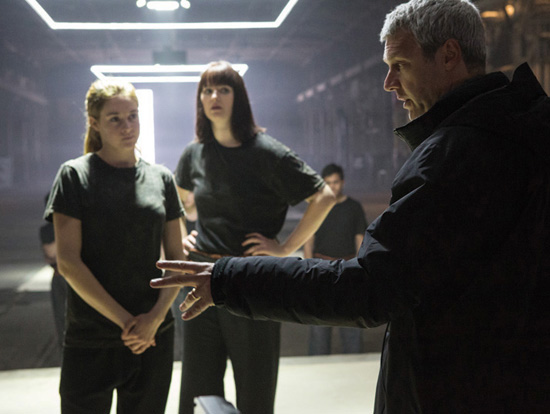
Neil Burger directs Shailene Woodley (Tris) and Amy Newbold (Molly).
A VISION FOR DIVERGENT
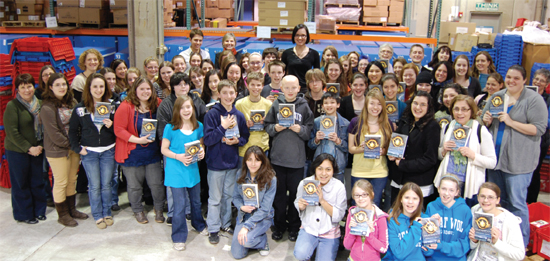
A group of enthusiastic readers with Veronica Roth (center) at Anderson’s Bookshop in Chicago.
Burger, Summit, and Red Wagon all shared a vision for the film version of Divergent. Even though it was set in the future, they all wanted the movie to feel current and relevant, as if it was really about now.
Once Burger signed on to direct—and began assembling a team that included a director of photography, a production designer, a location manager, a costume designer, and so forth—the whole group needed to articulate what that vision would really mean. Where would they make the movie? What would it look like? Who would the actors be? Preparing to shoot the film would take much longer than the shoot itself, as the team would plan every scene to the smallest detail.
The story would be told through dialogue, of course, rather than the narration of the novel. Screenwriter Evan Daugherty had already condensed a nearly 500-page novel into the 130-page script that would serve as Burger’s road map. But before Burger could get to the work of directing actors in performing that script, he would need to find ways to expand and extend all the visual detail that Roth had described in her book.
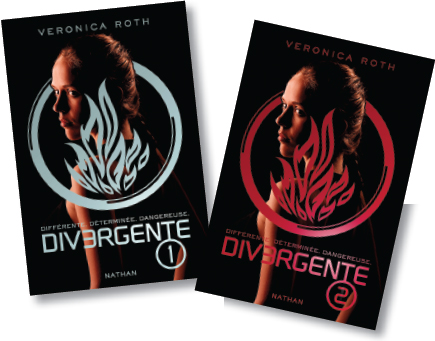
French editions of Divergent and Insurgent.

Four of the thirty foreign editions of Divergent: (L to R) Brazil, Spain, Russia, and Italy.
Early on, soon after the film rights were sold, Roth had met with producer Wick. At that point, she was less than a year out of college and on the verge of a kind of success that most people her age could only imagine. Roth remembers, “I wasn’t sure what to expect, but he was just so nice and so concerned about other areas of my life, like what it felt like to have this happen when I was only twenty-two. It felt like he was concerned about me as a human being, and that went a long way toward making me feel comfortable handing over my work to be interpreted by someone else.”
When the time came to expand on what she had written, then, Roth “had a little conversation with myself about ownership. When I write the story and it’s just in my computer, I’m the one who owns it. I control everything about it. But then when the book gets released, it suddenly belongs to millions of other people who are reading it. So that transfer of ownership happens from the second other people start reading the book. And it’s the same with the movie. The story now belongs not just to me, not just to the readers, but also to the director and to every actor they cast.”
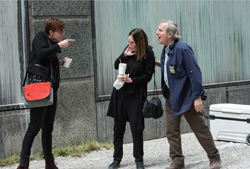
On the Divergent set with author Veronica Roth and producers Lucy Fisher and Doug Wick.
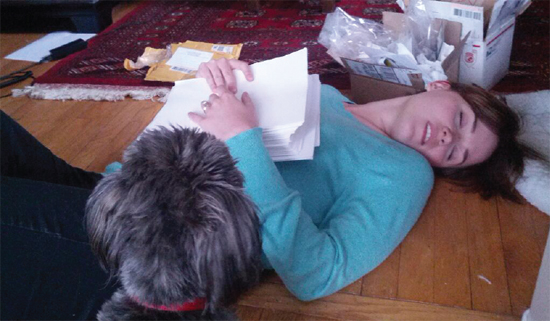
Author Veronica Roth is crushed by her editor’s notes on the massive Allegiant manuscript.
THE DETAILS EMERGE
By the time Burger consulted Roth about some of the details, Roth was well into writing Allegiant, the third book in the Divergent trilogy. She knew how Tris’s story would turn out, and she also knew more about what had happened, long ago, to create her dystopian society in the first place. Roth spoke at length with Burger about this backstory and shared information that no one but her editors knew yet. “I spoke with Neil about the surrounding world, and what had led to the city being created. He needed to know if he should depict any kind of destruction, and where it should be, and why it was there. I think Neil probably knows the most secrets of anyone,” Roth says. Still, Burger was curious about details she had never even considered.
She continues, “Neil asked me a lot of ‘detail’ questions, ones that Tris was unlikely to answer in the narrative—how does commerce work in each faction? Do the factions ever work together? What does that look like? Would there be any Amity present on Visiting Day? What kind of physical destruction is present in the city? Like that. In a movie, more so than in a book, you can show the world of a story in brief but significant ways—a shot of people walking down the street, for example, can contain a wealth of information. Neil wanted to make sure that the world surrounding the narrative made sense, that there weren’t any inconsistencies in the world-building, and that the world was rich. I’m not a big ‘describer,’ so seeing someone take my sparse settings and make them beautiful and detailed was . . . inspiring. Incredible.”
With Roth’s help, Neil Burger came to a basic understanding of the kind of society he would be showing on film. It would be about 150 years in the future, but a hundred years after an event that caused all technological advances to stop. Burger and his production team would need to imagine fifty years from now, and then decide what might be left over a century after that. What kinds of structures could withstand that test of time? What could be created from the few remaining raw materials the people had? None of these details were spelled out in Roth’s novel, but the filmmakers would use them as background as they began to make decisions about design.
The story is set in Chicago, a city of millions of people, but in Roth’s future city there are only about thirty thousand people. “They’re occupying this grand, slightly abandoned place,” says director Burger. “They keep up the areas that they use, but then there’s a vast area of the city which is kind of crumbling and falling apart. When we see the city, we just see people walking in the middle of the streets, because they don’t have cars. There are a few trucks around, but mostly their transportation is on foot or on train.” He and Roth even discussed what people in this city might use for power. If they had it, how did they get it? Eventually, he came to the idea that there could be wind turbines on the sides of some buildings and power cables swooping between them.
Roth smiles when she remembers some of her discussions with the filmmakers. “When I wrote the book, I was mostly concerned with Tris’s internal life, and she doesn’t notice all the details. She’s not a big describer of settings so, you know, I wasn’t thinking about what the chairs looked like or the needles looked like. I would never have been able to imagine all of that. Neil Burger has been one of the most detail-oriented and thoughtful people I have met through this whole experience. Talking to him, I’m sometimes like ‘I wish you had been here while I was building this world, because I think it would have been a little more fully realized if you had been around.’ He’s just so concerned with every little piece of the society and with representing it properly, even in the background.”

On location in Chicago, author Veronica Roth talks with director Neil Burger.
A CITY BECOMES A STAGE

At Chicago’s Navy Pier: the Ferris wheel, as imagined concept art in the film.
As his vision of this future Chicago began to come together, Burger came to an important conclusion: The real Chicago would be the only place to make this movie. Veronica Roth, in fact, had come to a similar conclusion as she was writing. “In the rough draft, the story wasn’t set in a real place—the world of Divergent was just a nameless urban environment,” she recalls. “And when I revised it, I realized that I wanted a greater sense of place to make the story feel more real. When I was trying to figure out the real environment it could take place in, I looked at what I already had, and I realized I had already set it in Chicago without meaning to, probably because it’s the city that I know and love the best.”
Just as Roth knew her story would resonate with readers if it were set in a recognizable place, Burger felt that the best way to make his film seem relevant and relatable was to plant it someplace real. Once he’d made up his mind, he didn’t even consider other possibilities.
Making a movie in Chicago would create certain complications: Transportation could be difficult in a major city at rush hour, for instance, and renting urban space could strain his budget. But with a real city as his stage, Neil Burger knew he could create a certain look. He remembers, “Even though it’s set a hundred and fifty years in the future, we’re on the streets in the real sunlight against the real buildings, and that just gives the film a completely different kind of energy than we see in other films set in the future. I knew I wanted to use Chicago as Chicago and shoot scenes like street photography, almost. I wanted it to look fresh and unusual.”
To create this effect, Burger sent location manager James McAllister on a mission to identify as many Chicago locations as he could. Before the rest of the film crew arrived, McAllister was visiting every notable spot in town.
And at the same time, Burger was beginning to assemble a cast.
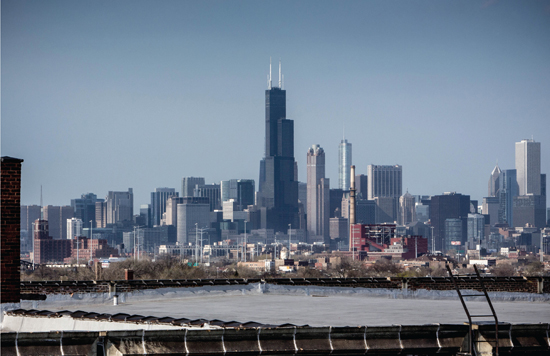
Chicago’s famous skyline.

Concept art for Chicago of the future, including the El train tracks.